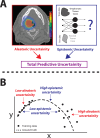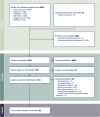This is a preprint.
Artificial Intelligence Uncertainty Quantification in Radiotherapy Applications - A Scoping Review
- PMID: 38798581
- PMCID: PMC11118597
- DOI: 10.1101/2024.05.13.24307226
Artificial Intelligence Uncertainty Quantification in Radiotherapy Applications - A Scoping Review
Update in
-
Artificial intelligence uncertainty quantification in radiotherapy applications - A scoping review.Radiother Oncol. 2024 Dec;201:110542. doi: 10.1016/j.radonc.2024.110542. Epub 2024 Sep 17. Radiother Oncol. 2024. PMID: 39299574 Free PMC article.
Abstract
Background/purpose: The use of artificial intelligence (AI) in radiotherapy (RT) is expanding rapidly. However, there exists a notable lack of clinician trust in AI models, underscoring the need for effective uncertainty quantification (UQ) methods. The purpose of this study was to scope existing literature related to UQ in RT, identify areas of improvement, and determine future directions.
Methods: We followed the PRISMA-ScR scoping review reporting guidelines. We utilized the population (human cancer patients), concept (utilization of AI UQ), context (radiotherapy applications) framework to structure our search and screening process. We conducted a systematic search spanning seven databases, supplemented by manual curation, up to January 2024. Our search yielded a total of 8980 articles for initial review. Manuscript screening and data extraction was performed in Covidence. Data extraction categories included general study characteristics, RT characteristics, AI characteristics, and UQ characteristics.
Results: We identified 56 articles published from 2015-2024. 10 domains of RT applications were represented; most studies evaluated auto-contouring (50%), followed by image-synthesis (13%), and multiple applications simultaneously (11%). 12 disease sites were represented, with head and neck cancer being the most common disease site independent of application space (32%). Imaging data was used in 91% of studies, while only 13% incorporated RT dose information. Most studies focused on failure detection as the main application of UQ (60%), with Monte Carlo dropout being the most commonly implemented UQ method (32%) followed by ensembling (16%). 55% of studies did not share code or datasets.
Conclusion: Our review revealed a lack of diversity in UQ for RT applications beyond auto-contouring. Moreover, there was a clear need to study additional UQ methods, such as conformal prediction. Our results may incentivize the development of guidelines for reporting and implementation of UQ in RT.
Conflict of interest statement
Conflicts of Interest: KAW serves as an Editorial Board Member for Physics and Imaging in Radiation Oncology. CDF has received travel, speaker honoraria and/or registration fee waiver unrelated to this project from: The American Association for Physicists in Medicine; the University of Alabama-Birmingham; The American Society for Clinical Oncology; The Royal Australian and New Zealand College of Radiologists; The American Society for Radiation Oncology; The Radiological Society of North America; and The European Society for Radiation Oncology.
Figures







References
-
- Rajpurkar P, Chen E, Banerjee O, Topol EJ. AI in health and medicine. Nat Med 2022;28:31–8. - PubMed
-
- Begoli E, Bhattacharya T, Kusnezov D. The need for uncertainty quantification in machine-assisted medical decision making. Nature Machine Intelligence 2019;1:20–3.
-
- Abdar M, Khosravi A, Islam SMS, Rajendra Acharya U, Vasilakos AV. The need for quantification of uncertainty in artificial intelligence for clinical data analysis: increasing the level of trust in the decision-making process. IEEE Systems, Man, and Cybernetics Magazine 2022;8:28–40.
Publication types
Grants and funding
LinkOut - more resources
Full Text Sources
